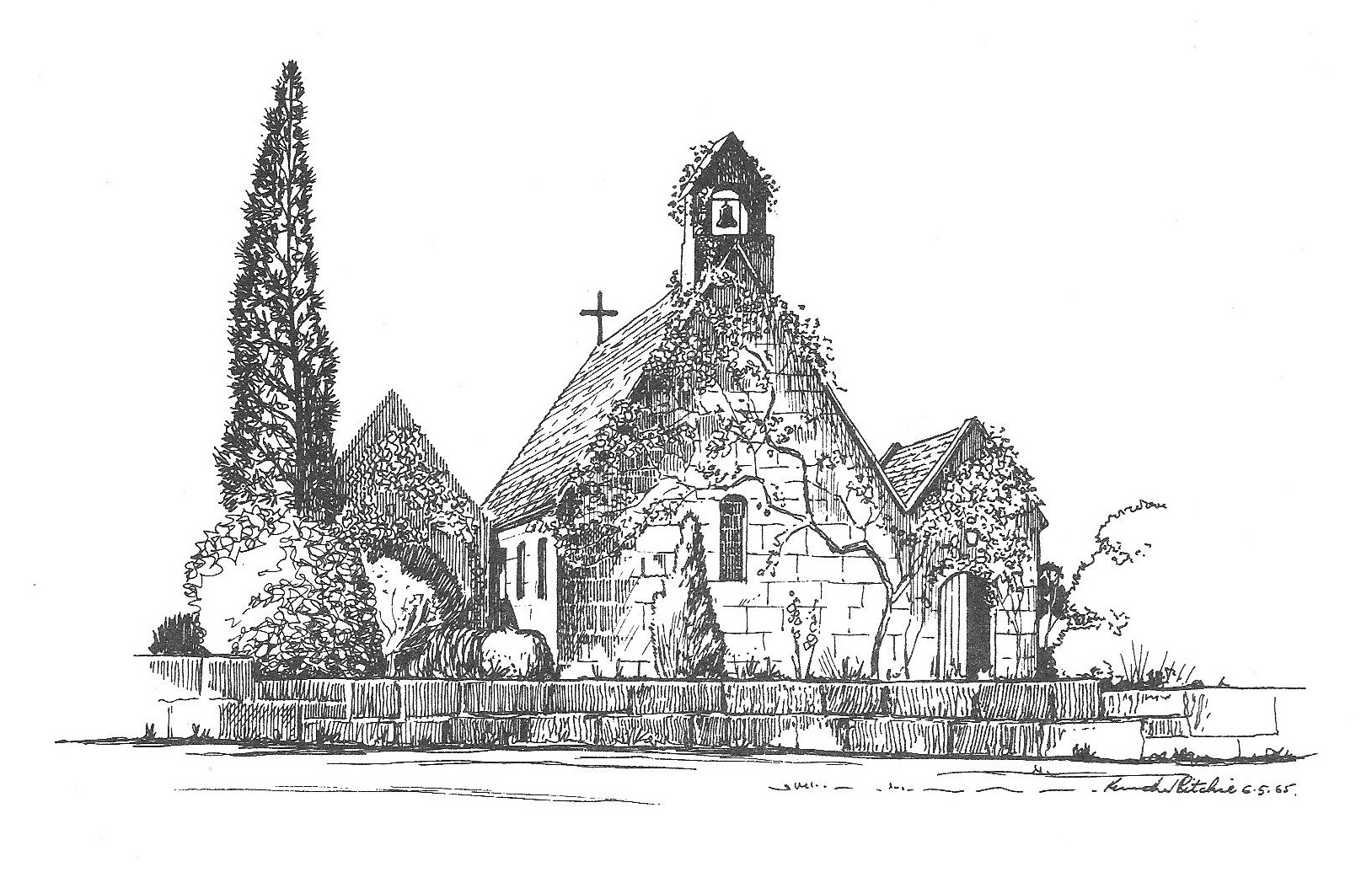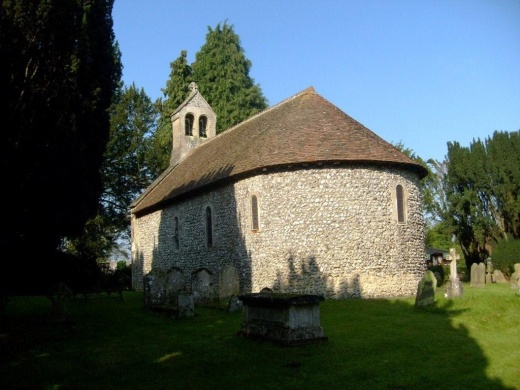Our Parish History
The history of Dural Parish reminds us of God’s faithfulness in using his people to bring about his purposes.
Beginnings
Anglican ministry in the district of Dural began in the early years of the 19th century with occasional visits by clergyman such as Rev Samuel Marsden to the sawyers and pioneer farmers of the area. In 1839 Rev William Clarke was appointed by Bishop Broughton as the first minister of the newly created parish of Castle Hill and Dural, although there was no church building as such in the parish. A Church of England denominational school already existed at Dural in 1839 but it was not until 1846-48 that the church of St Jude’s was built at Dural on what was then the Great North Road to the Hunter Valley. In Castle Hill, the former Government barracks building was used (and named St Simon’s) for church services from 1839 until 1861, when the church of St Paul’s was opened.
The First Century
Dural remained part of the parish of Castle Hill from 1839 to 1937. In that period, three Anglican branch churches were built in the Dural district: Kenthurst (1887), Annangrove (1899) and Arcadia (1907). Dural Public School took the place of the denominational school in 1869. St Jude’s Anglican Cemetery at Dural was opened in 1876 and is still in use for parishioners. A Parish Hall was built at Dural in 1914-16 on the site of the old school house.
In the first hundred years or so of St Jude’s existence, the main families who led activity at the church included the Bests, the Moores and the Fullers.
Becoming a Parish
In 1937 St Jude’s Dural became a Provisional Parish, with Rev Ronnie O’Brien being appointed the first Rector. During his incumbency (1937-1949), three more branch churches were added to the new parish: Galston (1938), Annangrove (1939) and Glenorie (1941). Dural became a fully fledged Parish in 1947.
The branch structure of Dural parish reached its peak with the addition of Hillside in 1951, bringing the number of churches to be serviced by the Rector to seven. The administrative pendulum began to swing in the opposite direction in the 1970’s, with Kenthurst acquiring the status of a separate Provisional Parish, and the branch churches of Glenorie, Hillside and Annangrove being closed. Galston followed suit in 1983, leaving Arcadia as the sole remaining branch church in the parish of Dural.
Most Recently
A new, larger building for church services and other parish functions was completed in late 1979 on the Dural site; the original church of St Jude’s also continues to be used for regular services.
Since 2005, the Anglican churches at Dural, Kenthurst and Arcadia have combined to form the re-named parish of Dural District.

- Our Cemetery
- List of Rectors
- List of Wardens
- Architectural Origins of St Jude's
- Historical Notes on St Jude's Church
The St Jude’s cemetery is in Old Northern Rd, about 500m south of St Jude’s.
Street address: 883-887 Old Northern Road, Dural NSW 2158
Burials in the cemetery are listed here, based on church records and transcription work done by the Dural Historical Society (last updated January 2023).
The Dural district was part of the Anglican Parish of Castle Hill from 1839 until 1937, when it became a separate parish. A list of the Rectors of Castle Hill Parish from 1839-1937, and of Dural Parish from 1937 to the present, with the date of their licence, is provided below. The dates of birth and death are mainly taken from an appendix in “Sydney Anglicans” (1987) by Stephen Judd & Kenneth Cable.
Castle Hill
July 1839: William Branwhite Clarke (1798-1878)
1845: Thomas Horton (1807-1896)
1 October 1856: Arthur Douglass (1816-1878)
1 July 1860: Robert Taylor (1834-1907)
15 January 1866: Henry Ham Britten (1836-1913)
31 January 1877: John Theophilus Schleicher (c1816-1892)
1 December 1885: Charles Henry Gibson (1846- ?)
16 June 1887: Francis (Frank) Rowling Elder (1855-1931)
23 July 1892: Edward Hargrave (1860-1920)
23 June 1899: Edward Glanville Cranswick (1853-1934)
1 July 1910: William John Roberts (1865-1938)
1 January 1925: Thomas Knox (1891-1972)
30 December 1931: Herbert Eric Felton (1899-1964)
Dural
1 December 1937: Ronald (Ronnie) Arthur O’Brien (1908-1998)
1949: Albert Thomas Pitt-Owen (1912-1997)
2 September 1953: Dennis George Hampton Johnson (1921-1998)
18 July 1956: Keith Henderson Marr (ca 1919-2019)
23 October 1958: Kenneth (Ken) James Leask (ca 1920-2008)
3 March 1961: Victor (Vic) William Roberts
30 October 1964: William (Bill) James Lawton
15 September 1967: Brian Franklin Vernon King (1938-2006)
7 October 1973: Donald (Don) Jesse Wilson
26 June 1985: Gerald Beckett
28 April 1998: Fergus Semler
1 February 2013: Adam Arnold Bennett Lamb
31 January 2018: Dougal Colin Michie
Churchwardens are normally appointed and elected at the parish’s annual general meeting. Each year one churchwarden is appointed by the Rector and two are elected by parishioners. The (incomplete) list below is drawn from surviving parish records, starting from 1881.
| Year | Rector’s Wardens | Parishioners’ Wardens |
| 1881 | Edward Fuller (1855-1938) & Thomas Best (1845-1905) | |
| 1882 | J. Foster | Edward Fuller & Thomas Best |
| 1883 | J. Foster | Edward Fuller & Thomas Best |
| 1884 | J. Foster | Edward Fuller & Thomas Best |
| 1885 | Samuel Moore (1841-1919) | Edward Fuller & Thomas Best |
| 1886 | Samuel Moore | Edward Fuller & Thomas Best |
| 1887 | ||
| 1888 | Edward Fuller | William Best (1847-1895) & Thomas Best |
| 1889 | ||
| 1890 | ||
| 1891 | ||
| 1892 | William Best & Thomas Best | |
| 1893 | Edward Fuller | William Best & Thomas Best |
| 1894 | ||
| 1895 | Edward Fuller | William Best & Thomas Best |
| 1896 | Henry Best (1864-1934) | Thomas Best & Frank Viney |
| 1897 | Henry Best | Thomas Best & Frank Viney |
| 1898 | Henry Best | Thomas Best & Frank Viney |
| 1899 | Henry Best | Thomas Best & Frank Viney |
| 1900 | Henry Best | Thomas Best & Frank Viney |
| 1901 | Henry Best | Thomas Best & Frank Viney |
| 1902 | Henry Best | Thomas Best & Frank Viney |
| 1903 | ||
| 1904 | ||
| 1905 | ||
| 1906 | ||
| 1907 | ||
| 1908 | Mr Turner | Edward Fuller & Arthur John Best (1853-1921) |
| 1909 | Mr Turner | Edward Fuller & Samuel Moore |
| 1910 | Frank Viney | Edward Fuller & R. Turner |
| 1911 | Frank Viney | Edward Fuller & R. Turner |
| 1912 | Frank Viney | Edward Fuller & R. Turner |
| 1913 | R. Turner | Edward Fuller & Frank Viney |
| 1914 | R. Turner | Edward Fuller & Richard Marquett Blaxland (1866-1942) |
| 1915 | Edward Fuller | R.M. Blaxland & Samuel Moore (1841-1919) |
| 1916 | Edward Fuller | R.M. Blaxland & Samuel Moore |
| 1917 | Edward Fuller | R.M. Blaxland & Samuel Moore |
| 1918 | Edward Fuller | R.M. Blaxland & Samuel Moore |
| 1919 | Edward Fuller | R.M. Blaxland & Samuel Moore |
| 1920 | Edward Fuller | R.M. Blaxland & J. St George |
| 1921 | Edward Fuller | R.M. Blaxland & George Best |
| 1922 | Edward Fuller | Arthur Edgar Best (1882-1954) & J. Fuller |
| 1923 | Edward Fuller | William Moore (1868-1937) & George Thacker |
| 1924 | ?Edward Fuller | |
| 1925 | Edward Fuller | Roy Best (1897-1986) & A.N. Thomas |
| 1926 | Edward Fuller | Roy Best & A.N. Thomas |
| 1927 | Edward Fuller | Roy Best & A.N. Thomas |
| 1928 | Edward Fuller | Roy Best & P. Thomson |
| 1929 | Edward Fuller | Roy Best & A.N. Thomas |
| 1930 | Edward Fuller | Roy Best & A.N. Thomas |
| 1931 | Edward Fuller | Roy Best & A.N. Thomas |
| 1932 | Edward Fuller | Roy Best & Alan Blaxland (ca1904-1984) |
| 1933 | Edward Fuller | Roy Best & Alan Blaxland |
| 1934 | Edward Fuller | Roy Best & Alan Blaxland |
| 1935 | Edward Fuller | Roy Best & Alan Blaxland |
| 1936 | Edward Fuller | Roy Best & Alan Blaxland |
| 1937 | Edward Fuller | Roy Best & Alan Blaxland |
| 1938 | George Deaman (d. 1960) | Roy Best & Robert Ham (ca1869-1953) |
| 1939 | George Deaman | Roy Best & Robert Ham |
| 1940 | Roy Best & Norman Livsey Rohan (1906-1981) | |
| 1941 | ||
| 1942 | ||
| 1943 | ||
| 1944 | ||
| 1945 | ||
| 1946 | ||
| 1947 | ||
| 1948 | ||
| 1949 | ||
| 1950 | ||
| 1951 | ||
| 1952 | ||
| 1953 | ||
| 1954 | Thomas (Tom) Roden (1901-1984) | Roy Best & Ellis Branz (1907-1982) |
| 1955 | Thomas Roden | Roy Best & Ellis Branz |
| 1956 | Thomas Roden | L. Buckeley & Ellis Branz |
| 1957 | Thomas Roden | L. Buckeley & Ellis Branz |
| 1958 | Thomas Roden | Robert Badger (ca1890-1963) & Ellis Branz |
| 1959 | Thomas Roden | Robert Badger & Ellis Branz |
| 1960 | Thomas Roden | Robert Badger & Ellis Branz |
| 1961 | Thomas Roden | Robert Badger & Ellis Branz (later J. Eggleston) |
| 1962 | Thomas Roden (?) | |
| 1963 | Thomas Roden | Martin Brown & J. Eggleston |
| 1964 | Thomas Roden | Martin Brown & J. Eggleston |
| 1965 | Thomas Roden | Martin Brown & J. Eggleston |
| 1966 | Thomas Roden (?) | |
| 1967 | Thomas Roden (?) | |
| 1968 | Thomas Roden (?) | |
| 1969 | Thomas Roden (?) | |
| 1970 | Thomas Roden (?) | |
| 1971 | Thomas Roden | Geoffrey (Geoff) Walker (1924-2010) & Donald (Don) Hann |
| 1972 | Donald Hann | Geoffrey Walker & Dr Saxton (1926-2005) |
| 1973 | Donald Hann | Geoffrey Walker & Barry Hobart |
| 1974 | Donald Hann (later Barry Hobart) | Barry Hobart (later Richard Wright) & Alton Musto |
| 1975 | Barry Hobart (later Alex Lee) | Alex Lee (later Edward (Ted) Riley) & Geoffrey Walker |
| 1976 | Alex Lee | Graham Fairbairn & Thomas (Tom) Webb |
| 1977 | Alex Lee | Graham Fairbairn & John Griffiths |
| 1978 | Alex Lee | Graham Fairbairn & James (Jim) Peddie |
| 1979 | Alex Lee | James Peddie & Vittoria Smith (1913-1986) |
| 1980 | Alex Lee | James Peddie & Vittoria Smith |
| 1981 | Alex Lee | James Peddie & Vittoria Smith |
| 1982 | Alex Lee | James Peddie & Vittoria Smith |
| 1983 | Alex Lee | James Peddie & Vittoria Smith |
| 1984 | Mark Sutherland-Harris | James Peddie & Vittoria Smith |
| 1985 | Mark Sutherland-Harris | Wendy Varcoe & Stephen Lo (1942-2010) |
| 1986 | Mark Sutherland-Harris | Wendy Varcoe & Stephen Lo |
| 1987 | Mark Sutherland-Harris | Wendy Varcoe & Robert (Bob) McKew |
| 1988 | Mark Sutherland-Harris | Cynthia Marriott & Arthur Field |
| 1989 | Mark Sutherland-Harris | Cynthia Marriott & |
| 1990 | Arthur Field | Cynthia Marriott & Graeme Dodds |
| 1991 | Arthur Field | Cynthia Marriott & Ross Waddington |
| 1992 | Arthur Field | Cynthia Marriott & Robert McKew |
| 1993 | Arthur Field | Margaret Turner (1925-2009) & Robert McKew |
| 1994 | Robert McKew | Margaret Turner (later Margaret Duckworth) & Mark Sutherland-Harris |
| 1995 | Robert McKew | Margaret Duckworth & Mark Sutherland-Harris |
| 1996 | Robert McKew | Margaret Duckworth & Mark Sutherland-Harris |
| 1997 | Mark Sutherland-Harris | Susan (Sue) Hargraves & Graham Brown |
| 1998 | Mark Sutherland-Harris | Susan Hargraves & Graham Brown |
| 1999 | Mark Sutherland-Harris | Susan Hargraves & Graham Brown |
| 2000 | Graeme Dodds | Susan Hargraves & Nicholas (Nick) Dahdah |
| 2001 | Graeme Dodds | Susan Hargraves & Nicholas Dahdah |
| 2002 | Graeme Dodds | Susan Hargraves & William (Bill) Drew |
| 2003 | Arthur Field | Susan Hargraves & William Drew |
| 2004 | Arthur Field | Susan Hargraves & William Drew |
| 2005 | Arthur Field | Susan Hargraves & William Drew |
| 2006 | Arthur Field | Susan Hargraves & William Drew |
| 2007 | Arthur Field | Susan Hargraves & William Drew |
| 2008 | Hilton Bell | Arthur Field & Alison Guthrie |
|
2009
|
Hilton Bell | Alison Guthrie & Ross Pendlebury |
| 2010 | Hilton Bell | Alison Guthrie & Ross Pendlebury |
| 2011 | Hilton Bell | Alison Guthrie & Ross Pendlebury |
| 2012 | Ross Pendlebury | Alison Guthrie & Arthur Field |
| 2013 | Ross Pendlebury | Alison Guthrie & Arthur Field |
| 2014 | Gregory Denton | Alison Guthrie & Nicholas (Nick) Maude |
| 2015 | Gregory Denton | Alison Guthrie & Nicholas (Nick) Maude |
| 2016 | Andrew Junor | Dana Gruben & Nicholas (Nick) Maude |
| 2017 | Andrew Junor | Dana Gruben & Nicholas (Nick) Maude |
| 2018 | Joel Fulton | Dana Gruben & Andrew Junor |
| 2019 | Hilton Bell | Dana Gruben & Andrew Junor |
There are four examples of such a church in England. If St Jude’s church is based on one of these, the mostly likely model is St Swithun’s church, situated in the village of Nately Scures, near Basingstoke, Hampshire. It is similar in appearance and size to St Jude’s, although built of different local materials.
Another reason for speculating that there is an architectural link between the two churches is that Bishop William Broughton, who authorised the building of St Jude’s, lived for nine years in the nearby village of Hartley Wespall, Hampshire, before he came to New South Wales. It is possible that he had the church at Nately Scures in mind when the design of St Jude’s was decided.
Read the article Who Designed St Judes AHS article 2007 for more detail on this subject.
Here are some downloads of historical interest (including some parish records). The following downloads are made available for public viewing. Parish permission should be sought for any use intended for publication or profit.

St Swithun’s Church, Nately Scures, Hampshire, England, built circa 1150-1175.
South-east aspect, showing the apsidal east end; the bell gable dates from the 19th century
